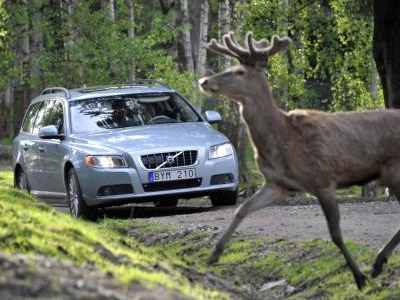11 June 2011 - The Swedish automaker, known for manufacturing some of the safest cars out there, is currently working on a new technology that is meant to help reduce the risk of collisions with wild animals. The new safety system alerts and automatically brakes for animals on the road, and is based on technologies from the Pedestrian Detection with Full Auto Brake, introduced in 2010.
The system will be designed to also work in the dark, since most collisions with wild animals take place at dawn and dusk and during the dark winter months. With thousands of motorists across the globe killed in accidents caused by collisions with wild animals each year, the aim of the project is to develop a safety system that reduces the risk of collisions with said wild animals. The new system is based on technologies from Pedestrian Detection with Full Auto Brake and will be launched on the market in a few years’ time, Volvo says.
The system consists of two parts - a radar sensor and an infra-red camera that can register the traffic situations. The camera monitors the road ahead and if an animal is within range the system alerts the driver with an audible signal. If the driver does not react, the brakes are automatically applied.
"The goal is for the system to function at the normal rural highway speeds. In cases in which it cannot help the driver entirely avoid the collision, the system will slow down the car sufficiently to help reduce the force of impact and thus of serious injuries," said Andreas Eidehall, technical expert in the field of active safety systems at Volvo Car Corporation.
In the first stage, the system will respond to large animals that risk injuring the driver or passengers in an impact, such as moose, deer and reindeer. The greatest danger is from collisions with moose. ("In an impact with a moose there is a relatively high risk of personal injury since it is common for the animal to end up on or roll across the front of the car and its windscreen," added Eidehall.
The company says that the greatest danger is from collisions with a moose, or Eurasian elk, if you prefer. In an impact with an Alces alces, there’s a relatively high risk of personal injury, since it’s common for the animal to end up on or roll across the front of the car and its windscreen.
The project has been under way for just over a year, though a lot of work still remains to be done. Various technologies are currently being evaluated and software is being developed. And while the system “learns” to recognise various animals, development is also under way on the necessary decision-making mechanisms, which is how and when the protective system is activated to respond.


